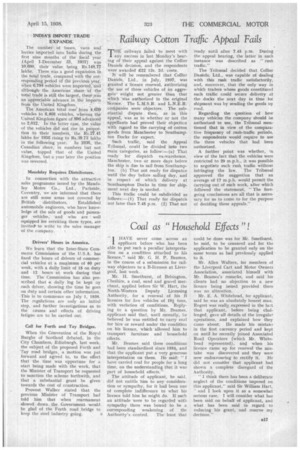Railway Cotton Traffic Appeal Fails
Page 27

If you've noticed an error in this article please click here to report it so we can fix it.
THE railways failed to meet with any success in last Monday's hearing of their appeal against the Collier Daniels decision, and the respondents were awarded 222 12s. 2d. costs.
It will be remembered that Collier Daniels, Ltd., in July, 1937, was granted a licence renewal, authorizing the use of three vehicles of an aggregateweight not greater than that Which Was authorized in the original licence. The L.M.S.R. and L.N.E.R. companies were objectors. The substantial dispute then, as in this appeal, was as to whether or not the appellants had proved their objection with regard to the carrying of cotton goods from Manchester to Southampton Docks for export.
Such traffic, said the Appeal Tribunal, could be divided into two main categories, as follow:—(a) That ready for dispatch ex-warehouse. Manchester, two or more days before the ship is due to sail from Southampton. (b) That not ready for dispatcn until the day before sailing day, and in respect of which delivery at -Southampton Docks in time for shipment next day is needed.
This traffic could be subdivided as follows:—(1) That ready for dispatch not later than 7.45 p.m. (2) That not ready until after 7.45 p.m. During the appeal hearing, the latter in such instance was described as "rush traffic."
The Tribunal decided that Collier Daniels, Ltd., was capable of dealing with this rush traffic satisfactorily, and, moremer, that the only way in which traders whose goods constituted such traffic could secure delivery at the docks the next day in time for shipment was by sending the goods uy road.
Regarding the question of how many vehicles the company should be authorized to use, the Tribunal mentioned that in view of the comparative frequency of rush-traffic periods, the respondents would require to use the three vehicles that had been authorized.
A further point was whether, in view of the fact that the vehicles were restricted to 20 m.p.h., it was possible to negotiate such rusk traffic without infringing the law. The Tribunal approved the suggestion that an average of 17 m.p.h. would permit the carrying out of such work, after which followed the statement, "The foregoing conclusions are all that is necessary for us to come to for the purpose of deciding these appeals." .




















































































